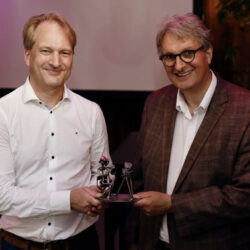African savannah shows what supply chain needs

The supply chain can still learn a lot from the savannah, it emerged during the SCM Directors Event. Just before Eline Oudenbroek was presented as list leader of the Top 26 Supply Chain Directors in the Netherlands, Marco Schreurs gave an explanation of high-performance organizations. Using examples from the animal kingdom, he explained what an organization needs to excel structurally. ‘African wild dogs cherish long-term thinking.’
The African wild dog is the most successful hunter on the savannah. Whereas lions and cheetahs respectively see 30% and 50% of their hunting attempts end in success, African wild dogs score a success rate as high as 80%. Their secret? Cooperation, tenacity and efficiency. They hunt as a team, with each animal having its own role. They pair speed with stamina, allowing them to keep hunting for a long time. And when they return to their pack, they regurgitate some of the devoured meat for the young and sick dogs that had to stay behind.
‘These animals cherish long-term thinking,’ says Marco Schreurs, leadership specialist and co-author of the book ‘Animal Firm’. ‘That African wild dogs feed the stragglers has a reason. They know they will eventually have to travel after their prey. Therefore, they try to keep their pack as fit and healthy as possible so that they can all move on together. Together, these animals form a high-performance organization.’
Five HPO factors
Schreurs is a partner at the HPO Centre, which conducts research on high-performance organizations (HPOs). These are organizations that achieve both financial and non-financial results that are significantly better than comparable organizations. ‘And they do that over a period of at least five years, by focusing in a disciplined way on what is really important for the organization. So an HPO is not an organization that runs after every new management hype.’
The HPO Centre analysed 505 studies on HPOs on 189 different characteristics. This resulted in a list of five HPO factors with 35 HPO characteristics. ‘To be clear: this does not include any financial characteristics. A bonus structure, for example, stands in the way of long-term success. And the term strategy appears only once in the list. With the characteristic that the HPO’s strategy must be unique.’
Matriarch of the flock
Schreurs discusses the five HPO factors one by one using examples from the animal kingdom. The first factor is the quality of management. A good manager is reliable, has integrity, is decisive and action-oriented, radiates self-confidence, and acts as a role model and coach. ‘You have to be in touch with your employees, enter into a dialogue with them,’ says Schreurs. ‘The example is the matriarch of a herd of elephants. She constantly checks how everyone is doing, stands in front of the herd in case of danger and gives direction when the herd moves on.’
Another factor is the pursuit of continuous improvement and innovation. Schreurs shows a video of the ingenuity of crows using the busy city traffic to develop a new way of cracking nuts. ‘With processes, we are not just talking about improving them, but also fine-tuning and simplifying them. The latter, in particular, proves to be quite difficult in practice. Many companies are busy improving processes, but the question is whether this also simplifies them.’
Sharing knowledge and learning from mistakes
In addition, an HPO is an organization that is open and action-oriented. An organization in which employees are open to change, share knowledge with each other and learn from each other’s mistakes. ‘A good example is the way ants communicate with each other by secreting pheromones. When an ant has found something, it leaves a scent on its way back. The route where the scent lingers the longest is the most efficient route. As a result, all ants follow the same route, one behind the other,’ Schreurs explains.
The fourth HPO factor concerns the quality of employees. HPO employees have a sense of responsibility, are flexible and tenacious, are open to feedback, and are good at both internal and external cooperation. Diversity is another important characteristic, such as in the savannah, where giraffes, ostriches, wildebeests and zebras are most successful together. ‘The last factor is the long-term orientation found in African wild dogs. With the characteristics that the customer always comes first and that employees feel safe and stay with the organization for a long time.’
High-performance partnerships
The HPO Centre conducts research not only on high-performance organizations but also on high-performance partnerships (HPPs). Many characteristics that determine the success of HPPs are familiar to supply chain directors: openness, action orientation, knowledge sharing and process alignment. ‘There must also be equivalence: equal influence, fair decision-making and timely communication,’ Schreurs says. ‘The last factor is about conflict management. What if things go wrong? How do you resolve that? That is about aligning objectives, dealing with differences and building trust.’










